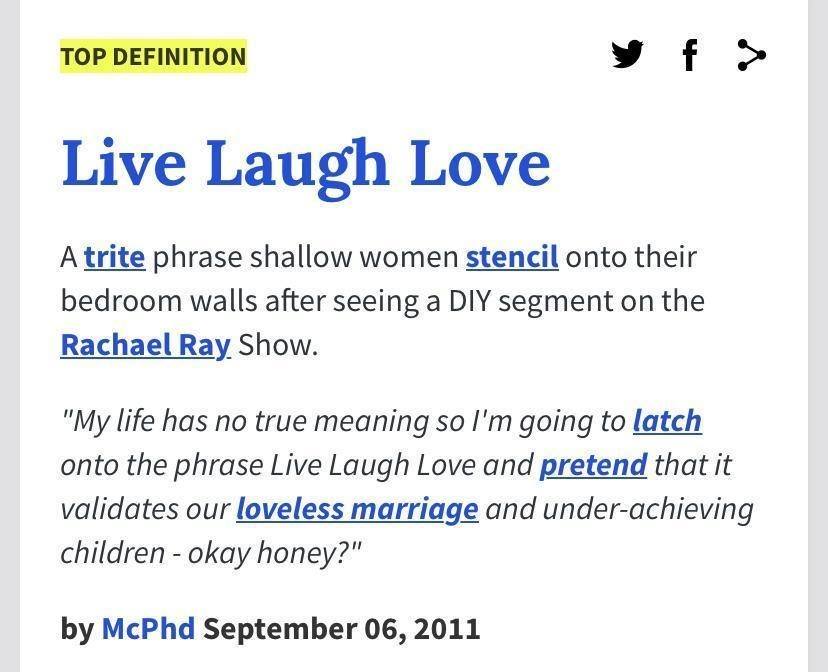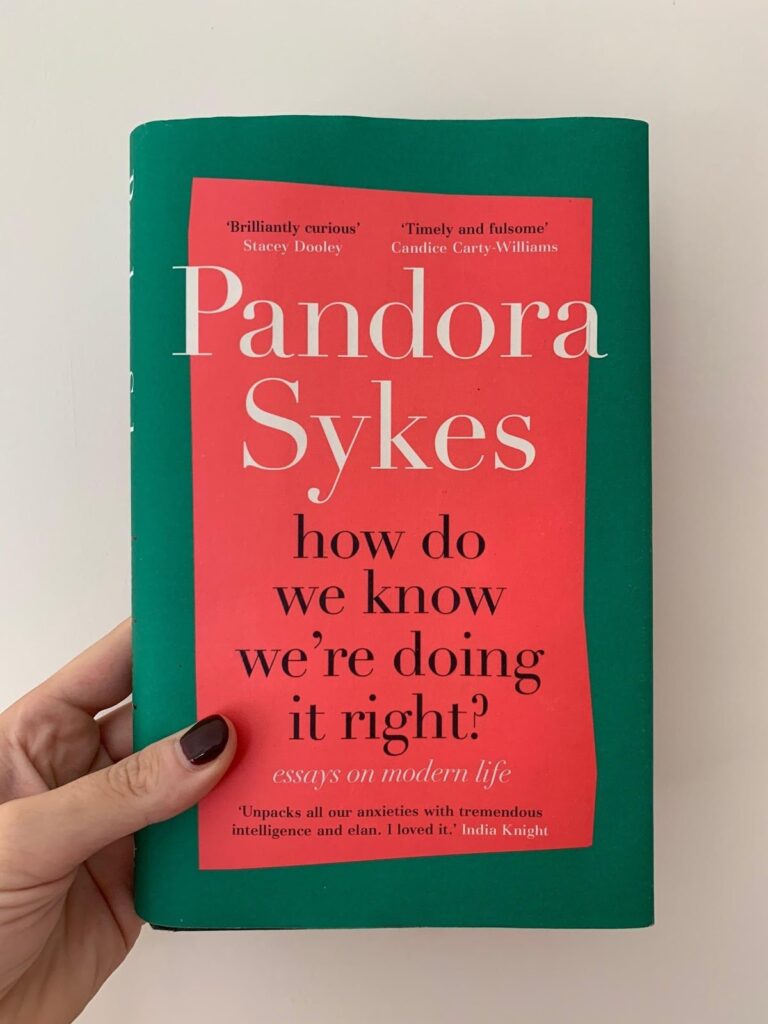Words by Libby Mills
‘Live. Laugh. Love.’ three little words that, circa 2010, seemed to be popping up everywhere. Whether it was on an inscribed piece of shabby-chic drift-wood hanging up in your friend’s kitchen, the mug you were sipping your choice of beverage from or the PJ’s that the model in the George Asda campaign was wearing – they were everywhere.
These three famous words were originally inspired by the Bessie Anderson Stanley poem ‘Success’, which opens with:
“He has achieved success / who has lived well, / laughed often, and loved much”
A century on, #LiveLaughLove has essentially become a staple part of meme culture. In 2011 Urban Dictionary user ‘McPhd’ submitted their own definition of #LiveLaughLove – a definition that has seemed to be largely agreed on and that has stuck.

Whether you choose to truly #LiveLaughLove your way through life, of which there are plenty of clothing, interior and stationary sites dedicated to the philosophy – Google at your own pleasure – or adopt its ironic and humorous adaptation, it represents an industry that is currently booming.
According to the Global Wellness Institute, the wellness industry was worth $4.2 trillion in 2019. Between 2015 and 2017 it grew by 12.8% and in total has a global economic output of 5.3%. Wellness includes all activities that help boost your overall wellbeing – these being physical, mental, emotional and spiritual. Anything that makes you look and feel good can be classified to be a positive contributor to your wellbeing.
In a world where we are bombarded by gadgets that help us save time, only to free up more time for us to do more, incorporating wellness into your life is understandably appealing. The World Health Organisation (WHO)’s report, ‘Mental health and well-being in the workplace’ shared how burnout and other stress-related conditions include high-blood pressure, sleeping disorders as well as a general low resistance to infections. They also stated how work-related stress is a major reason for absence, as well as early retirement. The subject of activity density has been explored in great depth by sociologists, in regards to how we divide our time. With the productivity market being worth $82 billion and wellness being linked to accessing your best self in order to cope with the un-ending demands we face, it can be easy to fall into the trap of toxic productivity. The wellness industry, despite first impressions, creates a false perception that we need to be in a constant state of self-improvement. Whilst also providing solutions to a very real need to ‘cope’.
So, not only does the wellness industry offer an abundance of opportunities to feel better about yourself – which is always rather tempting and a core premise to the individualistic society enabled through capitalism – there is a proven genuine global need for a collective improvement of our wellbeing. This has provided the wellness industry with the perfect, well-trained customer: one that returns and in-tow brings new customers along with them.
Pandora Sykes, journalist, writer and podcaster, recently published her first book ‘How do we know we’re doing it right?’ a collection of essays written by herself on modern life. It’s an excellent read that covers trials and tribulations millennial women – and early Gen Z’s – face. From the balancing act of being an empowered working woman in the 21st century, who still needs to shrink herself as and when to not come across as too much, to how wellness has now just become another thing we need to do. If we’re not partaking in self-care, we’re failing. We’re letting ourselves go, if we don’t have a mind-body-emotional-spiritual balance that we are now told we oh-so need in order to be happy and fulfilled. Pandora addresses the ambiguity surrounding ‘wellness’, which has, in turn, allowed it to be incorporated into an increasing amount of products or experiences we consume. Wellness is the new hottest western selling trend.

Wellness is: ‘celery juice, turmeric lattes, pink Himalayan salt lamps, activated charcoal, gratitude journals, colouring books, detox cleanses, face masks, chia seeds, matcha powder, alkaline water, raw water, rose quartz water…pillow spray, mindfulness apps, massage, CBD oil, anything pre-fixed by ‘green’ or ‘raw’, bubble baths, running a bath, just looking at a bath.’ ‘Just looking at a bath’ is an under-stated humorous take on just how ambiguous wellness really is.
While wellness can be, it seems, anything. There are clear aspects of the industry that are accessible only frequently, if at all, to the middle-upper class. All of the equipment, paid classes or workshops, retreats, subscriptions, specific food ingredients are largely inaccessible to the majority. Gwyneth Paltrow’s GOOP brand, which initially began as an online newsletter in 2008 concerning yoga and juice cleanses, was worth a cool $250 million in 2018. Last summer she held a summit ‘In GOOP Health’ at a wellness sanctuary in Hammersmith. Ticket prices ranged from £30-£4,500, something for every budget it could be argued. However, somehow anything that costs £4,500 in the name of wellness – without taking into consideration other expenses necessary in order to attend in the first place – beckons almost exclusively the white-upper-class-elite. Despite GOOP having over 1.5 million followers on Instagram and over 2 million annual website views, GOOP has come under fire on numerous occasions. Health professionals have accused GOOP of making unsubstantiated health claims, resulting in them paying over £100,000 in civil penalties in 2018 alone. Perhaps, exposing a naivety of wellness consumer culture.
During the last few months, the world has seen itself face a period unlike any other. For some, their world has ground to halt, with life becoming slower and simpler. For others, particularly key workers, their world has only intensified to an unimaginable level. COVID-19, globally, has been a different experience for everyone. However, one thing that has seemed to be undoubtedly on the rise is the perception that this time is a period for even further bettering one’s self. As if we don’t already engage in the subtle – yet obvious – competitions involving one’s self against…one’s self enough, it’s only gone and dramatically intensified. Out of the shadows, an enhanced toxic productivity has been emerging. From banana-breading, to blogging, to learning a new language, to never-failing-to-upload daily walk pics, to completing an array of Shaw Academy courses because, why not? Even self-care seemed to become a competition. Perhaps it’s withdrawal symptoms from a world we have adapted to, to where if we are in fact not being productive, what’s the point? Every moment of anything has to be ‘earned’. It seems, amongst many other lessons, periods of lockdown are teaching us we do need to slow down. Queue: wellness, the perfect antidote.
It seems the wellness industry won’t be slowing down anytime soon and with the world facing a pandemic, people are turning to wellness more than ever. It seems to be providing a genuine (being serious now) comfort to many. For some, it might just be the making of their 5th tea of the day, for others, it may be the purchase of a £175 Active Botanical Serum. Regardless of your personal association with wellness, we could probably all do with a little more #LivingLaughing&Loving.

